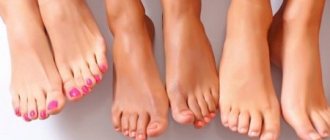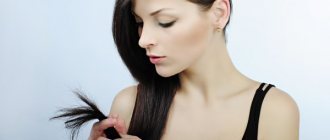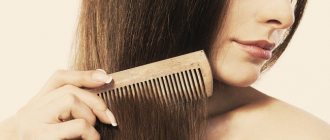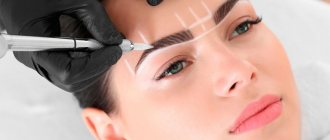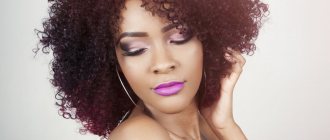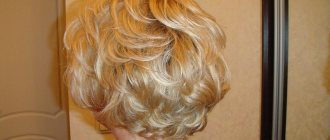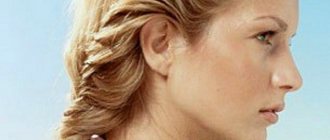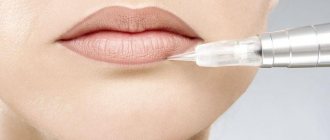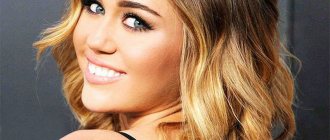Hair extensions have been a leader among hairdressing services for several years now. It allows you not only to significantly adjust the natural length of the strands, but also to add volume to them. The essence of hair extensions is to attach artificial curls to natural hair, which, as a rule, are much longer than the “native” ones. Thus, in literally a matter of hours you can become the owner of beautiful long and thick hair that will look as natural as possible.
Hair extensions are very popular among those women who like to experiment with their appearance. Moreover, many women, having grown their strands, wonder: is it possible to style them or color them? We want to talk about the features of care, coloring and correction of such curls in more detail. Therefore, we invite you to familiarize yourself with the material that will reveal all the secrets of the procedure and operation of “donor” strands.
Caring for hair extensions
Since the procedure involves attaching artificial strands to natural ones using tapes or capsules, several important rules must be taken into account in hair care. To avoid damaging the junction of the strands, it is better to use a special soft bristle comb for combing. This comb, unlike conventional brushes based on plastic or wood, allows you to comb your hair as gently as possible, eliminating damage to the capsules.
It is recommended to comb your hair, starting from the ends and gradually moving towards the roots. This procedure can be carried out three or more times a day to avoid tangling of curls and the formation of tangles at the place where the capsules are attached. Wet or wet strands should never be combed.
It is important to note that sleeping with your hair down is also not recommended. To avoid the formation of tangles, make it a rule to braid them or collect them in a ponytail with a soft elastic band. Don't go to bed until you dry your hair - this can greatly ruin the appearance of your strands.
Styling hair extensions
As for styling, you can use a hairdryer, tongs, curlers and curling irons, but only if they are not used in places where artificial strands are attached to natural strands.
Note that when choosing products for styling hair extensions, pay attention to cosmetic products that are gentle, without impurities or additives. At the same time, try to do your hair with the utmost care so as not to damage the capsules.
You can braid and gather your braids into a ponytail yourself, but if you decide to do a complex styling, then it’s better to contact a specialist. Also use the services of a hairdresser if your strands are very tangled and you cannot solve the problem yourself. If tangles form, in order not to aggravate the situation and not to lose the attached curls, contact the specialist who did the extensions and ask for help to return the hairstyle to its “marketable appearance”.
How to wash your hair extensions
In addition, it is very important to consider some rules for washing your hair to prevent damage to the capsules.
Rules for washing your hair:
- Before washing your hair, be sure to comb your hair so that the strands do not get tangled during the process of lathering with shampoo;
- wash your hair in an upright position - this will also avoid the formation of tangles;
- It is recommended to wash your hair as it gets dirty, but not more than 4 times a week to avoid drying out the scalp;
- products such as masks, balms and conditioners should be applied only from the middle of the hair length, avoiding the places where the curls are attached.
When it comes to choosing a shampoo to care for your hair extensions, the best product would be a mild, sulfate-free shampoo for normal hair. Also pay attention to shampoos with moisturizing ingredients. But it is better not to use shampoo for oily hair, as it will dry out the extensions.
It is best to dry your hair naturally, but if you use a hairdryer, use a warm stream of air, but never hot air.
Risks when dyeing yourself
Before you decide to dye your hair extensions yourself, you should weigh all the risks. The fact is that the result of dyeing such hair can be unpredictable:
- It is not known for sure whether the strands were dyed previously and with what, the color may turn out unexpected;
- it is necessary to take into account the structure of the hair, for example, Slavic strands are more “sensitive” to dye compared to Asian ones. Budget category hair is given a marketable appearance using silicones and other active substances that change the structure. Then even an experienced colorist does not always cope with his task.
The extension procedure is not cheap, and any manipulation at home can lead to disastrous results. Additional risk factors include the following:
- paint may damage the fasteners;
- color distortion possible;
- damage to donor strands is possible;
- the master knows more about the structure, quality of the material used, interaction with other substances;
- The warranty on the extension itself is canceled.
Some masters allow you to do the coloring yourself. But in this case, they simply relieve themselves of any responsibility, shifting it onto the shoulders of clients.
Dyeing your hair extensions yourself is at your own risk!
Is it possible to dye hair extensions?
Another question that concerns many owners of curl extensions: is it possible to dye after extensions? Experts recommend dyeing only regrown roots, which differ from artificial strands. You can also dye your extensions, but only if they are made from natural hair.
Bleached or Asian hair cannot be dyed because it is pre-treated with a special chemical composition. Moreover, for extensions it is better to use ammonia-free dye.
As for the extended strands of the European or Slavic type, they can be dyed, but only in a darker shade. It is impossible to lighten such curls. Well, in order to avoid getting the coloring composition into the places where the capsules are attached, it is better to entrust the procedure of coloring the curls to a professional.
What paint to use
Products with a low oxidizing agent content, no higher than 3%, are suitable for coloring hair extensions. This means that you will have to say goodbye to all the inexpensive and aggressive paints of the mass market. Instead, professional products are used, preferably without ammonia and specially designed for treating hair extensions.
As an alternative to permanent paints, there are tinted shampoos, tonics and balms. They allow you to change the tone slightly and briefly, but do not cause any harm to the strands. We have also prepared for you a review of the best ammonia-free hair dyes.
You can only change the color towards darker or slightly lighter. Under no circumstances should you radically lighten your hair extensions.
Correction of hair extensions
If you decide to undergo this procedure, then be prepared for the fact that you will have to regularly visit a hairdresser to correct your hairstyle. Since natural hair tends to grow back over time, the attachment points need to be adjusted. Moreover, with prolonged use of extensions, they often become tangled and sometimes fall out. In this case, the attachment points become visible to prying eyes, so in order to restore the beauty of the hairstyle, it is necessary to carry out a correction.
As a rule, the correction procedure is carried out every two to three months. It is done as follows: first, the capsules are removed and the fallen hairs are then combed out with a fine-toothed comb. Next, a special liquid is applied to the strands, which dissolves the obsolete capsules. The next step is to remove the old capsules and replace them with new ones. The last stage is extension of the strands, as in the original version. However, with correction, hair length decreases by about 3-5 centimeters. It is not recommended to carry out the correction procedure yourself, since it requires the skills and knowledge of a professional.
The hair correction procedure is quite lengthy and can take up to 4-5 hours of your time.
How to paint correctly at home?
The following tips will help you avoid DIY dyeing mistakes.
How long after extension?
After extensions, you can dye your hair no earlier than on the 3rd–4th day. If you paint before the specified period, the tape strands will come off, and the capsules will not be able to hold the strands as before. After all, the composition includes embalming and moisturizing components that weaken the fastenings.
On which strands is the procedure impossible?
Regarding the possibility of dyeing hair extensions and the choice of dye, you should consult with the specialist who carried out the extensions.
But strands of some materials cannot be exposed to such effects at all; this applies to all artificial fibers. Even fashionable and wear-resistant Kanekalon cannot withstand such exposure.
Oxide concentration to lighten
It is not recommended to bleach your hair after extensions!
It is better to use darker colors than those of your native hair and extensions. The fact is that when bleaching, oxidizing agents with a concentration of at least 9% are used. This can ruin the donor strands, since often the material has already been dyed during production.
Products with a high concentration of oxidizing agents will cause dryness, dullness, and brittleness. It is better to give preference to dyes with an oxidizing agent of 3–6% or ammonia-free products.
Number of tubes
The amount of paint depends on the thickness and length of the strands:
| Length | Density | Number of tubes |
| Shoulder-length | Average | 2 |
| Up to the shoulder blades | Average | 3 |
| Up to the shoulder blades | More than 120 strands extended | 4 |
| Below the shoulder blades | Average | 3 |
| More than 65 cm | Average | 5 |
Basic Rules
Extension experts recommend dyeing only the upper part of the head (the so-called cap on the top of the skull) at home, without affecting the extended strands.
The color change should be within 2-3 tones, no more. If you want to change the color completely, then first check the result on strands hidden from prying eyes - for example, extensions behind the ear.
Apply the mixture to dry, dirty hair - at least 48 hours must pass since the last wash.
Any paint that gets on the capsule or tape must be removed quickly, otherwise the fastening material will be damaged.
Procedure
Staining is carried out in the following sequence:
- Apply the paint to the roots and keep it on as per the instructions (usually 20–30 minutes).
- Apply dye to your own hair.
- After 5 minutes, paint is applied to the extended strands.
- After 5–10 minutes, the paint is washed off.
For washing, use a special shampoo or regular detergent, but for oily or normal hair. Using detergent on dry hair can cause hair strands to come loose.
The paint is washed off in the shower, keeping your head straight, paying special attention to the root zone. Care products are also applied carefully, bypassing the fastenings. These products usually contain a lot of vegetable oils for shine. It’s even better to use special skincare products.
If the roots have grown
Blonde for long hair never goes out of style. And the question often arises: how to lighten the roots? It is recommended to carry out coloring together with correction - strands are removed, lightening is carried out, and re-extension is performed. If the correction is not coming soon, but you need to look your best, then you can lighten the root zone only on the top layer of hair.
There are often reviews online that girls dyed and even bleached their roots on their own, and the capsules withstood this test. But before you experiment, it’s worth thinking about - materials of different quality are used for extensions. Therefore, procedures often end in failure.
How to remove hair extensions
The procedure for removing hair extensions, as well as correction, requires knowledge of special skills, so you cannot carry out the manipulation yourself. Remove the extended strands with special forceps, having previously treated the bonding areas with a gel or liquid that softens the capsules. The details of removal depend on the method by which the hair extensions were performed, so they are removed by the same specialist who did the extensions.
That's probably all you need to know. We hope that our information is useful to you.
What kind of paint can be used
When choosing a product for coloring hair extensions, it is best to purchase paint with a lower percentage of oxidizing agent, within 3%.
The price of such a dye will be an order of magnitude higher than that of inexpensive and aggressive mass-market paints. These products are professional, they do not contain ammonia and many of these dyes are intended specifically for hair extensions.
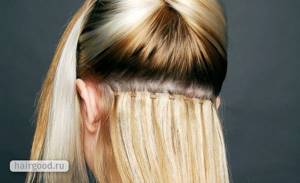
If you choose a more gentle dyeing method, you can use tonics, tinted shampoos and balms. They won't do any harm. And the shade will change, albeit temporarily.
If you dye your hair with tonic, it will not change its structure, will not become dry and will not lose its natural shine. However, the tone will not change much; a radical change in color cannot be achieved using this method.
The dye is washed off using a vertical shower. This way the strands will not tangle. Be sure to use a fixative afterwards. To keep the color saturated for as long as possible, use special products with a moisturizing effect.
It is also worth remembering that the color of hair extensions cannot be changed much; it is permissible to dye them a lighter or darker tone. Radical lightening can be detrimental to a new hairstyle.
The amount of paint is selected depending on the length of the strands:
- For medium length and thickness, up to approximately 40 cm, you will need two standard tubes and an oxidizing agent. The standard is 120 ml.
- If the curls are longer and lighter, then 3 tubes will be required.
- If there are a lot of extensions (more than 120), then it is advisable to take 4 tubes.
- For dark long hair that goes down below the shoulder blades, take 3 packs of dye.
- For lengths over 65 cm, you will need to take 5 packs.
Care after coloring
After coloring, nutrition and hydration are required, first of all, by your own hair. But extensions also need special care. In specialized stores you can purchase balms and masks designed specifically for artificial strands.

It is important to remember the general rules of care:
- Before going to bed, if your hair has been washed, you need to dry it well. It is best to loosely braid your curls or tuck them under a net.
- You need to purchase special shampoos for hair extensions. At the same time, they are used carefully, without roughly rubbing into the head. If it is useful to use vinegar or lemon water for rinsing with your own curls, then such a procedure will only harm the extended strands.
- You need to dry washed hair carefully, without twisting it, rubbing it or squeezing it. It is better to use a terry towel, pressing them lightly.
- It is best to dry naturally, or use a low setting on a hairdryer without pointing it at the attachment points.
- Apply combing only to dried hair, using a wide-toothed brush without balls at the ends.
- If there is a need to use varnishes, mousses and gels, then you need to choose products with a neutral pH.
- It is not advisable to swim in the sea, visit a bathhouse, solarium or sauna. Salt water dries out strands, and high temperatures can damage the fastening.
If you plan to dye your extensions, it is better to choose European or Slavic extensions for this procedure. But even such hair requires careful care, so you need to purchase gentle dye with an oxidizing agent content of no more than 3%.
Coloring hair extensions with tonic
When choosing between paint and tonic, it is best to give preference to the latter. There are several reasons for this.
- Coloring with tonic is the safest option for changing color.
- This procedure preserves the natural shine and appearance of the hair, while the use of dye makes it dry and unnatural.
When choosing a tonic, you should pay attention to its composition. A tonic for hair extensions should have a low content of oxidants, ideally no more than 2%. This will protect your hair from “drying out” and subsequent tangling. Well, who needs a “crow’s nest” on their head? The procedure for coloring with both paint and tonic is the same.
The main disadvantage of color correction using toner is its small variability and low durability. Hair color can only be changed by 1 - 2 tones; a radical transformation from brunette to blonde will not work.
- It is almost impossible to lighten artificially extended strands - any specialist will confirm this.
All smart people are determined by the required color scheme before extensions, and not after.
In fact, dyeing your hair in the desired color and choosing curls that match it in tone or, conversely, dyeing artificial strands in your natural shade is much easier than doing subsequent dyeing. But it happens that even with careful selection, after the procedure the shade of your own and “additional” hair differs. Then staining cannot be avoided.
